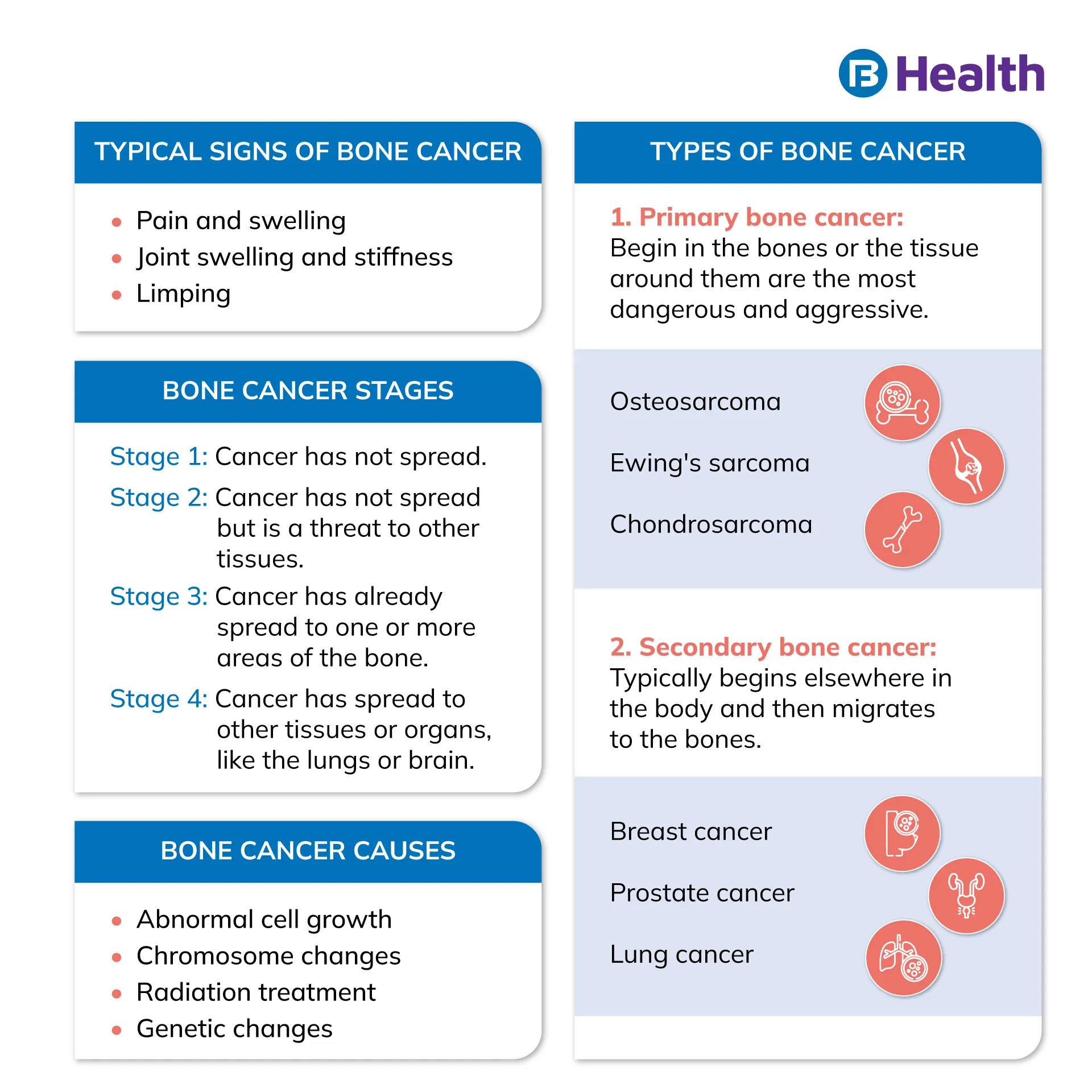Orthopaedic | 6 min read
Bone Cancer: Types, Stages, Medications, and Treatment
Medically reviewed by
Table of Content
Synopsis
In recent years, there have been significant changes in the interaction between cancer and bone. Oncology now has to deal with an increase in the prevalence of bone metastases, a dramatic shift in epidemiological data, and a significant clinical impact. Because of these factors, bone tumours are currently to blame for the high morbidity rate among cancer patients.
Key Takeaways
- The pelvis or the long bones in the arms and legs are the most typical areas affected
- Any bone in the body might develop bone cancer
- Less than 1% of all malignancies are bone cancers, making them extremely uncommon
Any bone in your body can develop into bone cancer, typically in the pelvic bone or one of the long bones in your arms or legs, such as the shinbone, femur, or upper arm. Bone cancer, a rare type of cancer, can be aggressive. Keep reading about bone cancer it's symptoms, causes, diagnosis, and types.
Types of Bone Cancer
Although less frequent, primary bone tumors that begin in the bones or the tissue around them are the most dangerous and aggressive. Secondary bone malignancies and metastasis from another body portion are more typical.
Primary Bone Cancer Subtypes
Osteosarcoma
Your knee and upper arm are common areas where osteosarcoma develops. Most cases occur in adolescents and young adults, although a different variety frequently affects individuals with Paget's disease of the bones.
Ewing's sarcoma
Ages 5 to 20 are the typical range for persons to develop Ewing's sarcoma. The most common locations are your upper arm, leg, pelvis, and ribs.
Chondrosarcoma
Most cases of chondrosarcoma affect adults between the ages of 40 and 70. This cancer typically develops in the hip, pelvis, leg, arm, and shoulder after starting in cartilage cells.

Other Types of Bone Cancers
Other malignancies can manifest in the bones. These consist of:
- Multiple myeloma: The soft tissue found inside the bones, called bone marrow, is where multiple myeloma begins.
- Leukemia: Leukaemia is the collective term for malignancies that primarily attack white blood cells in the body.
- Non-Hodgkin lymphoma: This type of cancer starts in the immune system's lymphocytes.
Secondary Bone Cancer
It typically begins elsewhere in the body. For instance, secondary bone cancer results from lung cancer that has migrated to your bones. Metastatic cancer is any cancer that spreads from one area of your body to another. The following cancers frequently progress to the bone:
Additional Read: Bursitis: 4 Important Points to Keep in MindSymptoms of Bone Cancer
- Pain and swelling: Pain and swelling where the tumor is placed are the bone cancer symptoms. Initially, the pain could come and go. Later, it may worsen and persist longer.
- Joint swelling and stiffness: Joint enlargement, tenderness, and stiffness can be brought on by tumors that develop in or around joints. Book online doctor consultation as soon as possible.
- Limping: If a tumor-bearing bone in the leg fractures or breaks, it may cause a noticeable limp. It is one of the bone cancer symptoms.
Bone Cancer Stages
Primary it is divided into stages. These several stages define cancer's location, its behavior, and the extent to which it has damaged other bodily parts:
- Stage 1: Cancer has not spread.
- Stage 2: Cancer has not spread but is a threat to other tissues.
- Stage 3: Cancer has already spread to one or more areas of the bone.
- Stage 4: Cancer has spread to other tissues or organs, like the lungs or brain.
Your orthopedic doctor may employ the following techniques to ascertain the stage of bone cancer and to decide on bone cancer treatment:
- A biopsy: To identify cancer by examining a small sample of tissue.
- A bone scan: To evaluate the health of the bones.
- A blood test: To create a baseline that will be used for treatment.
- X-rays, PET, MRI, and CT scans are imaging procedures used to provide detailed images of the structure of the bones.
Following a biopsy, doctors may grade tumors according to their appearance under a microscope. Typically, the more abnormal they seem, the quicker they can spread and expand. There are two grades of bone cancer: low grade and high grade.
A higher grade may indicate that the cells are more atypical and are likely to spread more quickly, whereas a lower grade may indicate that the cells are more regular and are likely to spread more slowly, like in Rickets disease. Doctors can select the bone cancer treatment with the help of the grade.

Bone Cancer Causes
Abnormal cell growth
Healthy cells frequently divide to replace aging ones and pass away. Atypical cells continue to exist. Tumor-like lumps of tissue begin to develop on them.
Chromosome changes
In osteosarcoma cases, 70% of patients showed unusual chromosomal traits.
Radiation treatment
It can be treated with radiation therapy, which eradicates hazardous cancerous cells. However, some patients who undergo the medicine may develop osteosarcoma. High radiation doses may hasten the development of this condition.
Genetic changes
Although it is uncommon, genetic alterations that increase the chance of getting it may be inherited. Additionally, radiation can cause mutations, and some modifications appear to have no apparent cause.
Additional Read: Fracture in Your BonesWho is Susceptible to Bone Cancer?
- A history of bone cancer in the family.
- Undergo radiation therapy or treatment in the past.
- Having Paget's disease results in abnormal bone growth after the bone breakdown.
- Many tumors in your cartilage, the connective tissue in your bones, either now or in the past.
- You may be more likely to have cancer if you have Li-Fraumeni syndrome, Bloom syndrome, or Rothmund-Thomson syndrome.
Bone Cancer Treatment Depends on
- Severity and stage of the illness
- Patient's age
- The general state of health
- Tumour size and location
Medications used to Treat Bone Cancer
- Drugs used in chemotherapy for multiple myeloma.
- Medicine to relieve the pain and swelling in bursitis.
- Bisphosphonates to stop bone thinning.
- Cytotoxic drugs to stop the spread of cancer cells.
- Immunotherapy drugs to improve the fight against cancer cells.
Therapies for Bone Cancer
Limb salvage surgery
The cancerous portion of the affected bone is removed, but no adjacent muscles, tendons, or other tissues are affected. The bone was replaced with a metal implant.
Amputation
Your doctor may amputate the limb if the tumor is big or has spread to your nerves and blood vessels. After that, you might be given a prosthetic limb.
Radiation therapy
It uses potent X-rays to kill cancer cells and reduce tumor size. Doctors frequently combine it with surgery.
Chemotherapy
This uses cancer medications to kill tumor cells. It may be prescribed by your doctor for metastatic cancer, to be used either before or after surgery.
Targeted therapy
It is a medication explicitly targeting specific genetic, protein, or other alterations in or near cancer cells.
It is significantly easier to treat in generally healthy individuals whose disease hasn't spread. Approximately 6 out of 10 individuals with bone cancer will survive for at least five years following their diagnosis, and many of these individuals may be totally cured. But, it is necessary to keep an eye out to ensure that the bone cancer doesn't return; by scheduling routine visits with your doctor. Bajaj Finserv Health offers to pay the medical bill by the health card & if you are not able to pay the bill amount you can convert your bill into easy EMI.
References
Disclaimer
Please note that this article is solely meant for informational purposes and Bajaj Finserv Health Limited (“BFHL”) does not shoulder any responsibility of the views/advice/information expressed/given by the writer/reviewer/originator. This article should not be considered as a substitute for any medical advice, diagnosis or treatment. Always consult with your trusted physician/qualified healthcare professional to evaluate your medical condition. The above article has been reviewed by a qualified doctor and BFHL is not responsible for any damages for any information or services provided by any third party.




